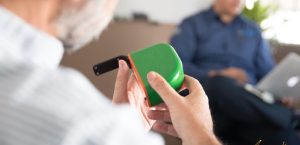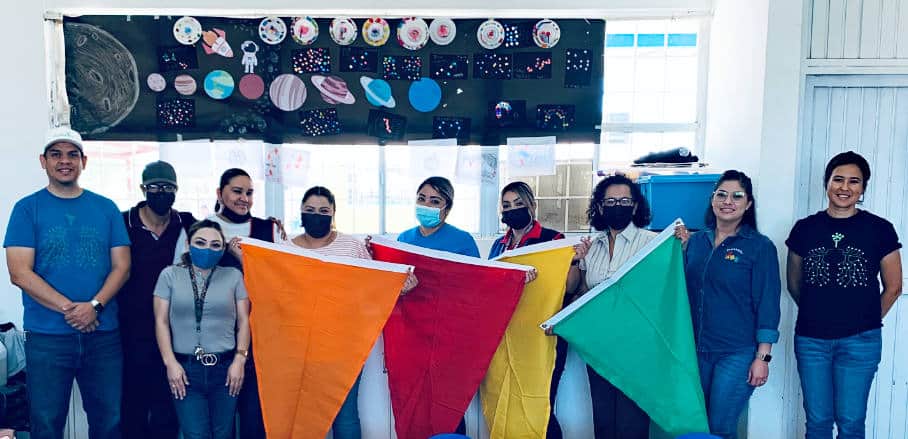Share Information. Transform Communities.
Every day millions of people around the world breathe in polluted air. After experiencing first-hand, the consequences of polluted air, Alberto Mexia Sánchez and his team developed their own technology to monitor air quality and to educate the people in Mexicali.
Mexicali, a city located on the northern border of Mexico and home to 1,049,792 people, according to the National Institute of Statistics and Geography. In 2021 18,903,389 vehicles crossed the border ports into the United States of America according to the Customs Border Patrol. Moreover, Mexicali has a rubbish collection deficit, so people burn it. There is a 45 per cent street paving deficit, and are lax standards for industrial emissions.
As a result, the city drew the attention of national and international media and caused outrage among the population, who wanted to verify what their health and discomfort had been telling them for some time: Mexicali was listed in 2010 as the city with the most polluted air in Latin America. On the other side, the authority justified the high levels of pollution by saying that the information was not representative of the urban area because it was located on the outskirts of the city, close to a rural, agricultural, and farming area. So, the mitigation strategy was to eliminate air quality monitoring in that area.
Five years later, while training to run my first marathon, I started to get sick after each training session, suffering from severe headaches, runny nose, dizziness, and sneezing; breathing in polluted air had damaged my body. This motivated me to study the problem and I came to understand that people’s health is severely affected by exposure to high levels of air pollution. Particularly children under the age of 4, pregnant women, older adults, and people with chronic illnesses are known to be sensitive groups. According to the World Health Organization: 9 out of 10 people in the world breathe polluted air.
Taking Matters into our Hands
Given the technical profile of our team, we decided to focus on a specific problem: in Mexico, there is a serious deficit of air quality monitoring. There is little information on pollution levels and most of it is unreliable because air quality monitoring equipment is not properly operated, and its components are not maintained or replaced. Moreover, most information is not delivered to the population in the format or in the time it is needed. This activity, by law, is strictly the responsibility of governments.
One of the reasons why governments in Mexico do not measure air quality is because it is expensive: about two hundred and fifty thousand dollars up front, plus the annual cost of operation, a city like Mexicali would require at least nine normative monitoring stations to have adequate coverage. In the past, Mexicali only had three normative monitoring stations to measure pollutant concentrations, but one of its flaws is, that they are not installed in high-risk areas such as the industrial zone. Plus, Mexicali has many unpaved streets, a deficit of close to 40 per cent due to growth and poor city planning.
In 2017, a part of our team attended an international workshop on low-cost monitoring networks at the Mario Molina Centre, at which Dr. Molina, a Nobel Prize winner in Chemistry, known for raising awareness about the effects of aerosols on the ozone layer, commented that while the use of regulatory stations is important, the cost and expansion advantages of using low-cost sensors under the Citizen Science modality is evolving.
So, we conducted a comparative analysis of low-cost sensor options and decided to design our own technology. Once we had the first prototype, we developed mobile applications and integrated the data into a Geographic Information System that would allow us to deliver the information in real-time and in a user-friendly way to the population, but we also designed the solution to integrate all kinds of low-cost sensors and regulatory stations operated by the government.
In December 2018 we introduced redspira.org to the world and since then, the project has taken us to places and times we never imagined. In Mexicali, we currently have 60 Redspira sensors, 60 low-cost American sensors, three Mexican government stations and the regulatory stations in the Imperial Valley, the border city on the U.S. side.
By now, we have 3 complete years of information, although the network grew progressively and not all areas of the city were measured. In 2018 we had only 15 sensors, and by 2022 we have about 140. We can see that by averaging and forming a single data point for the city, the data is very similar across these three years.
In addition to the sensors and platforms we have developed, we use NASA satellites and EPA platforms that are available to the public to understand phenomena beyond city behaviour. We have also installed panoramic cameras that allow us to identify and document emission sources. For example, in September 2020, we had about 15 days with poor air quality, when in that month there should not be high levels, thanks to the Fire and Smoke map of the United States Environmental Protection Agency (Us-EPA). We were able to understand that we were being affected by the smoke plume from the California and Colorado wildfires, a situation thousands of miles away and one we cannot control, but we were able to identify the causes and impacts of poor air quality to the public.

Redspira Sensor developed in Mexicali © Pablo Chee
From Technical Project to Social Movement
Redspira started as a technology-based project that over time became a social movement with four main axes: 1. Development and implementation of Civic Technology and Citizen Science, 2. Advocacy. 3. Public Policy and 4. Development of Environmental Education Materials and Programmes (Air Quality).
In coordination with other local environmental organizations, we incorporated the EPA’s Air Quality Flags Program in 100 schools, providing colour-coded flag kits associated with air quality indices (Green: Good, Yellow: Moderate, Orange: Unhealthy for Sensitive Groups, Red: Poor Air Quality, Purple: Dangerous) and educational materials for teachers to teach children how to protect themselves from pollution. Moreover, We created an educational version of one of the most traditional games in Mexico, “La Lotería de la Calidad del Aire”, in which we developed 52 air quality concepts linked to an illustration. During the pandemic, we organised online events and thanks to the EPA and the binational working group, we delivered 3000 Loterías to families in Mexicali and the Imperial Valley. We are currently developing a children’s story with “Arí”, a character made of air that travels through cities with different levels of pollution. With this, we seek to sow environmental knowledge in children from four to eight years old.
At the national level, in Mexico, we collaborate with the most recognised organisations in the Citizen Air Quality Observatory, where we promote initiatives and positions at the federal level. Currently, we continue to try to innovate and develop impact projects in the Imperial Valley – Mexicali region, but we have also linked up with the newly created “Coalición Latinoamericana por el Aire” in which we join civil society organizations in countries such as Colombia, Chile, Peru, Brazil, Ecuador, and Mexico.
The involvement of civil society in a task historically (and technically) in government control has forced authorities to pay greater attention to the problem, empowered citizens to democratise information and demonstrated that will is more important than politics. There is still a long way to go to achieve clean air, but strong civil society steps are being taken.
- Share Information. Transform Communities. - 15. September 2022
